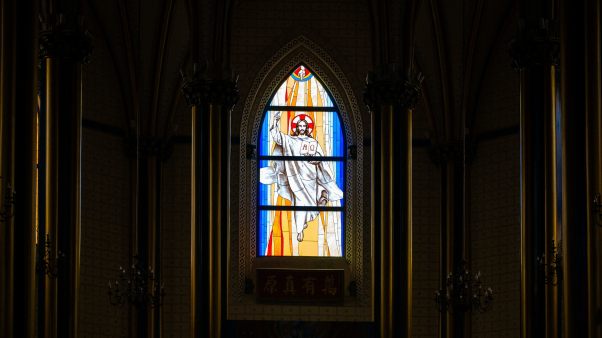First Kings carries the narrative of the history of the monarchy from the last days of David (c. 965 B.C.) to the death of Ahab (c. 853 B.C.). Among the highlights of this turbulent century are the economic grandeur and spiritual decadence of Solomon’s reign, the division of the kingdom by Rehoboam and Jeroboam, and the exploits of Elijah climaxed by his victory over the prophets of Baal in the contest on Mt. Carmel. Always a fertile source of preaching materials, I Kings at present deserves even closer attention in view of the increased light shed on its pages by archeological discoveries, historical research, and sociological insights.
Date, Authorship, Composition
The earliest date for the completion of the books of Kings is set by the description of Jehoiachin’s release about 560 B.C. (2 Kings 25:27–30). However, the bulk of the material was probably compiled and edited in the last years of the Southern Kingdom which fell in 587–586 B.C.
The highly stylized presentation of the history and the uniform theological outlook throughout the books seem to reflect the hand of a single compiler. The emphases on the ministry of Elijah, Elisha, and other prophets, along with the general prophetic tone of the editor, has caused many ancients and some moderns to single out Jeremiah as the compiler. Exact identification is impossible, but it is safe to say, with Driver, that the author was a “man like-minded with Jeremiah, and almost certainly a contemporary who lived and wrote under the same influences.” The impact of Deuteronomy on the compilers of Judges, I and II Samuel, and I and II Kings has often been pointed out. One can acknowledge that the former prophets bear the stamp of men influenced by the speeches of Deuteronomy without accepting a seventh century date for the composition of Deuteronomy. (For a recent defense of the Mosaic authorship of Deuteronomy see G. T. Manley, The Book of the Law. London: Tyndale Press, 1957). In the compilations of these editors we have the beginning of history writing. The former purely annalistic method, the mere chronicling of events, gives way in the former prophets to a subjective approach in which the eye and mind of the historian play important roles. Further, the historian ceases to be a court apologist glorifying the king, as was the custom among most ancient peoples (the Hittites being an exception), and frequently evaluates and criticizes the royal record as we see in Kings where some rulers are branded good and others evil.
Thanks to the fact that the compiler of Kings mentions some of his sources, we can gain some insight into his methods of composition. In all probability the bulk of the material concerning Solomon in 1 Kings 1–11 was drawn from the Book of the Acts of Solomon (1 Kings 11:4). In addition, there are frequent references to the Book of the Chronicles of the Kings of Israel and the similar record of the kings of Judah. Several of the kings are said to have employed a recorder (mazkir, one who causes to remember), whose duty undoubtedly was to keep an official record of the royal events. The Septuagint seems to suggest that the Book of Jasher (cf. Josh. 10:13) underlies 1 Kings 8:12–13 (LXX 8:53). The exploits of the prophets, especially Elijah and Elisha, were probably familiar to the compiler in oral form, as they had been preserved and circulated in prophetic circles.
The editor is by no means passive in his approach to the written and oral sources. He weaves the prophetic materials into the court journals with dexterity and takes great pains to combine records from both kingdoms into a synchronized historical narrative. Materials from the Northern Kingdom were probably brought to the south by refugees when Samaria fell before the Assyrians about 722 B.C.
All of those materials were filtered through the mind of the editor and bear his prophetic stamp with the result that “the Book is a history written with a religious and a practical aim.… The remarkable note is that when all was lost, someone found the history of that tragic period worth recording as a lesson of God’s discipline of His people.” (Montgomery-Gehman, ICC, pp. 44–45). The God who shaped the course of history guided the hand that wrote it.
The Chronological Puzzle
Bible students have long recognized that a simple addition of the regnal datings led to perplexing answers. E. R. Thiele achieved what appears to be a major breakthrough when he discovered that not the numbers but our methods of interpreting them were in error. In his The Mysterious Numbers of the Hebrew Kings (University of Chicago Press, 1951) Thiele resolves the major chronological problems for the period covered by I Kings (other adjustments are necessary for later periods) with the hypothesis that Judah used an accession year system of dating (i.e. the first year of a reign was not counted in the reckonings of years) while Israel used a nonaccession year system (i.e. the first year of a reign was counted). When this difference and the fact that Judah’s regnal year began in the month Tishri while Israel’s began in Nisan are taken into consideration, a harmonious synchronization is achieved without recourse to amending the numbers.
Archeological Light
Excavations over the past 30 years have brought to light such a wealth of material concerning the Solomonic period that biblical scholars can well appreciate the Queen of Sheba’s amazement at the splendor of the wise king’s domain. The discovery of Ezion-geber, Solomon’s industrial and commercial capital on the Gulf of Aqabah (1 Kings 9:27), has shed considerable light on this period. Among the fascinating finds was the copper refinery, equipped with flues and specially angled to utilize the prevailing winds to fan the refining fires. Metallurgists have expressed wonder as to how sufficient heat could have been generated to smelt the copper in the quantities suggested by the huge refining kettles. This outstanding mining and smelting enterprise made possible the casting of the great temple pillars, Jachin and Boaz, the molten sea, the 10 bronze lavers, and other vessels (1 Kings 7:15 ff.). For a firsthand account of Solomon’s mines and Ezion-geber one should consult N. Glueck’s The Other Side of the Jordan (New Haven: ASOR, 1940).
The administrative skills of Solomon (cf. 1 Kings 4) are evidenced not only in his constructing and managing of Ezion-geber, a well-planned and carefully engineered city, but also in his substantial enterprises in other cities, especially Megiddo. This perennial crossroads of the Levant was rebuilt by Solomon (1 Kings 9:15) and was a key citadel in his military enterprise. A huge stable capable of housing upwards of 450 horses and 150 chariots has been excavated among the other government buildings of Megiddo. The feeding and watering equipment and spacious layout testify to the prestige which the cavalry enjoyed in Solomon’s army. An example of Solomon’s chariot cities, Megiddo may also have been one of the centers of Solomon’s horse trading with the Hittite and Syrian Kings (1 Kings 10:26–29). Recent excavations at Gezer and Hazor have lent further testimony to the splendor of this period (cf. 1 Kings 9:15–17).
Further evidence of Solomon’s prestige is found in his marriage to the daughter of the Egyptian king (1 Kings 9:16). A recent writer has remarked: “Here we have a political occurrence without parallel not only in Israelite, but also in Egyptian history. As far as we know, there is no other real example of a Pharaoh’s daughter given in marriage to a foreign royal house.…” (A. Malamat, “The Kingdom of David and Solomon in its contact with Egypt and Aram Naharaim” in Biblical Archeologist, Dec. 1958, p. 97).
Solomon’s wide-spread commercial activity sheds light on the visit of the Queen of Sheba (1 Kings 10:1 ff.). This Arabian ruler may well have been affected financially by Solomon’s canny fiscal policies. His sea voyages, for instance, between Ezion-geber and Ophir (probably in East Africa) may have cut into her caravan trade. 1 Kings 10:13 seems to indicate that a satisfactory agreement was reached. Assyrian inscriptions of the eighth and seventh centuries B.C. mentioning Arabian queens show that the Queen of Sheba is by no means an isolated case of a woman ruler.
The most lasting and influential legacy of Solomon’s era was the temple of Jerusalem. Only during this period was there found in Israel the combination of wealth, international prestige, and respite from enemy attacks necessary to carry to completion a project of this scale. The resources of Solomon’s kingdom and the ties of friendship with Phoenicia (1 Kings 5:1) were exploited to the hilt to provide a worthy dwelling place for God. The foreign artisans were indispensable both because the pastoral life of the Israelites did not stimulate craftsmanship and because their prohibition against making any replica of the deity (Exod. 20:4) tended to curtail artistic activity.
Archeological discoveries in Canaan together with the fairly detailed biblical descriptions (1 Kings 5–8) have enabled scholars to make reasonable reconstructions of the temple and its furnishings. Caution is necessary, however, inasmuch as nothing of the temple remains and no Phoenician temple of the tenth century B.C. has yet been discovered. The shrine of Tainat in Syria, dating from the ninth century contains the same tripartite division—porch, nave (holy place), and inner sanctuary (holy of holies). A brief but helpful description of the temple is found in Andre Parrot’s The Temple of Jerusalem (London: SCM Press, 1957).
The Israelite king, Omri, merits only a few verses in the narrative (1 Kings 16:16–29), but one of his exploits had lasting significance for his country. After he revolted against and did away with Zimri, he transferred the capital from Tirzah to the city which he himself built on a hill he had purchased from Shemer—Samaria. In all probability it was the growing threat of invasion from Assyria, just beginning to reveal the traits of brutality and aggression which made her the scourge of the Middle East for over two hundred years, that caused the military tactician, Omri, to fortify the hill of Samaria. Here he and his illustrious successors, especially Ahab (c. 873–853) and Jeroboam II (c. 781–753), lived in moderate security and lavish splendor until the hill-fortress yielded to the relentless onslaughts of the Assyrian king, Sargon II, in 722 B.C.
Omri’s son Ahab enriched the city of his father by building an “ivory house” (1 Kings 22:39) whose splendor caused it to be numbered among his important deeds. This abundant use of ivory in Samaria was a symptom of decadent luxury to the austere soul of Amos (3:15; 6:4). J. W. Crowfoot and others, excavating Samaria between 1931 and 1935, found almost 200 ivory plaques or fragments of plaques within the palace of Ahab. The carvings and inlays on the ivories testify amply both to the lavish display of wealth and the syncretistic type of worship which the author of Kings and the eighth century prophets found offensive. Again we are indebted to Parrot for his Samaria, the Capital of the Kingdom of Israel (London: SCM Press, 1958), which traces the checkered history of the city from the time of Omri to that of John the Baptist.
Theological Emphases
In Kings we see prophetism in action. Elijah, the sturdy Tishbite, dominates the narrative from 1 Kings 17 until his ascension in 2 Kings 2, where his mantle falls on Elisha. These men of courage bridge the gap between early seers like Samuel, Nathan, and Gad and the great eighth century writing prophets, Hosea, Amos, Isaiah, and Micah. In their fierce and fearless denunciation of wicked kings, they follow in the train of Samuel and Nathan and point the way to the prophet Amos and also John the Baptist.
Our author’s interest in the prophetic outlook is by no means exhausted in the stories of Elijah, Elisha, the man of God from Judah and the old prophet of Bethel (1 Kings 13), and the other prophets. His interest in prophetism is reflected on almost every page by his handling and molding of his materials. An anonymous member of the prophetic company, he evaluates incisively each reign and condemns kings of both kingdoms who fall short of prophetic standards, especially in regard to idolatry (e.g., 1 Kings 16:31–33). The same Spirit of God that prompted Elijah to name Ahab as the true troubler of Israel (1 Kings 18:18) moved the author to brand all other idolatrous kings as troublers of Israel.
To understand the attitude of the author of Kings one must recall the terms of the Davidic covenant in 2 Samuel 7:12–17: (1) God would establish permanently the kingdom of David’s son; (2) God would enter into a father-son relationship with the king, punishing or blessing him according to his conduct; (3) the son would build a house for God’s name. The antipathy toward the Northern Kingdom stems from Jeroboam’s breach of this covenant by usurping part of the Davidic authority and establishing rival sanctuaries (1 Kings 12:28–33). No king who perpetuated this sacrilege could merit divine favor. Thus the Northern kings are uniformly condemned.
Tools For Understanding
The most valuable commentary on Kings is the volume in the International Critical Commentary by J. A. Montgomery and H. S. Gehman (Edinburgh: T. and T. Clark, 1951). It is essential to view the drama of Israel against the backdrop of her neighboring nations. Of the many recent histories which make the most of recent light on the entire Near East, I prefer C. H. Gordon’s Introduction to Old Testament Times (Ventnor Press, 1953) and H. M. Orlinsky’s Ancient Israel (Cornell University Press, 1954). We can also be grateful for an English edition of M. Noth’s substantial History of Israel (London: Adam and Charles Black, 1958). Geography, too, has come in for concentrated study of late. In addition to the revised edition of G. E. Wright and F. Filson’s Westminster Historical Atlas (Philadelphia: Westminster Press, 1956), L. H. Grollenberg’s admirable Atlas of the Bible (New York: Nelson, 1956) and E. G. Kraeling’s Bible Atlas (New York: Rand McNally, 1956) will give needed light to the historical background and the numerous geographical references in Kings. The quarterly Biblical Archeologist (New Haven: American Schools of Oriental Research) will keep one abreast of archeological findings. For questions of weather, topography, crops, etc., one should consult Denis Baly’s The Geography of the Bible (New York: Harper, 1957). Finally, the two indispensable volumes edited by J. B. Pritchard, Ancient Near Eastern Texts (Princeton University Press, 1950) and The Ancient Near East in Pictures (1954) will shed illumination on virtually every page of Kings.
DAVID A. HUBBARD
Westmont College, Santa Barbara, Calif.










